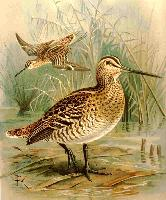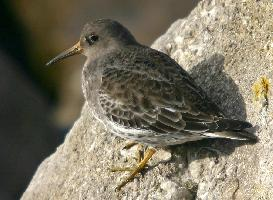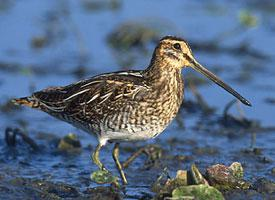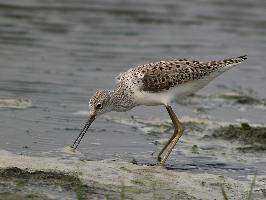
Popis zvířete
The Great Snipe (Gallinago media) is a fascinating bird species belonging to the sandpiper family Scolopacidae, which captivates birdwatchers and ornithologists with its unique characteristics and behaviors. This medium-sized wader is renowned for its elusive nature, making sightings a cherished moment for many bird enthusiasts.Morphologically, the Great Snipe is a robust bird, measuring approximately 26-29 cm in length, with a wingspan of around 42-47 cm, and weighing between 150-310 grams. It exhibits a relatively short, stocky body compared to other snipes, with a prominently long, straight bill that it uses adeptly to probe into soft mud or soil in search of its prey. The bill, measuring about 6-7 cm, is a critical adaptation for feeding, allowing the bird to reach deep into the substrate to find invertebrates, such as insects and their larvae, earthworms, and sometimes small amphibians and plant material.
The plumage of the Great Snipe is intricately patterned, serving as excellent camouflage within its natural habitats. The bird's back and wings display a mosaic of brown, black, and buff, with dark striping and spots that blend seamlessly into the marshy or grassy landscapes it frequents. Its underparts are lighter, typically a whitish or buff color, with distinct dark barring that becomes more pronounced during the breeding season. This cryptic coloration is a vital adaptation for avoiding predators and staying inconspicuous to both prey and humans.
Great Snipes are primarily found in the damp, grassy areas of northern Europe and parts of Russia, extending their range into Africa during the winter months. They favor habitats such as wet meadows, marshes, and the edges of lakes and rivers where tall vegetation provides cover and feeding opportunities. The species is migratory, undertaking long-distance flights between its breeding and wintering grounds, which is a testament to its endurance and navigational abilities.
Breeding behavior in Great Snipes is particularly interesting. Males are known for their remarkable courtship displays, which take place in communal leks where several males gather to perform for potential mates. These displays include a variety of vocalizations, from deep, resonant sounds to higher-pitched notes, accompanied by physical postures and movements designed to attract female attention. The lekking sites are traditional, used year after year, and can become quite competitive as males vie for the best positions.
Once a female chooses a mate, the pair will not form a lasting bond; the male may mate with several females, and the female will solely undertake the responsibility of incubating the eggs and raising the chicks. The nest is a simple depression on the ground, concealed by vegetation, where the female lays 2 to 4 eggs. The chicks are precocial, able to leave the nest shortly after hatching, though they remain dependent on the female for protection and guidance in finding food.
Despite its beauty and fascinating behaviors, the Great Snipe faces challenges from habitat loss and degradation, particularly due to agricultural expansion and land drainage. Conservation efforts are essential to preserve the wetland habitats these birds rely on for breeding and sustenance during migration.
In summary, the Great Snipe is a remarkable bird species, with its distinctive morphology, cryptic plumage, and intriguing behaviors. Its life cycle, from the spectacular courtship displays to the migratory journeys and solitary nesting habits, reflects the adaptability and resilience of this species in the face of environmental challenges.
Podobná zvířata
Nové fotografie zvířat
Top 10 zvířat
- Common cockchafer (Melolontha melolontha)
- Common house mosquito (Culex pipiens)
- Colossal squid (Mesonychoteuthis hamiltoni)
- Giant house spider (Eratigena atrica)
- Harpy eagle (Harpia harpyja)
- Fruit fly (Drosophila melanogaster)
- Common reed warbler (Acrocephalus scirpaceus)
- Australian box jelly (Chironex fleckeri)
- Proboscis monkey (Nasalis larvatus)
- Moustached guenon (Cercopithecus cephus)


